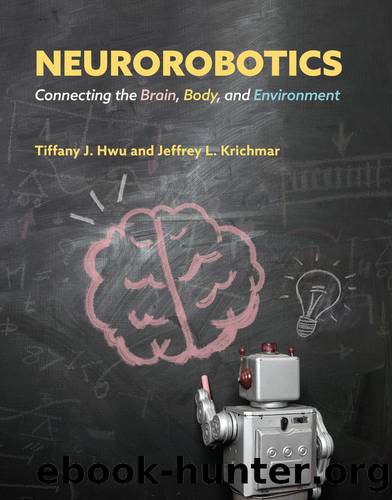Neurorobotics by Tiffany J. Hwu;Jeffrey L. Krichmar;

Author:Tiffany J. Hwu;Jeffrey L. Krichmar;
Language: eng
Format: epub
Tags: Autonomous Systems, Cognition, Intelligent Systems, Learning, Memory, Navigation, Neuroscience, Robotics
Publisher: MIT Press
6.2.1âMemory Consolidation and Spatial Memory
A brain region important for learning and memory is the hippocampus (see figure 6.1). The hippocampus is necessary to learn new memories and to consolidate those new experiences into long-term memories that can last a lifetime. The hippocampus can rapidly learn new autobiographical and semantic information, sometimes in the first experience (i.e., one-shot learning). Over time, this information becomes consolidated in the rest of the brain. Having a rapid learning system that can interact with a slower long-term storage area, which has been called a complementary learning system (Kumaran et al., 2016; McClelland et al., 1995), is thought to be the means by which our brains overcome catastrophic forgetting (i.e., forgetting previously learned information when learning new information). This aligns with the another memory model, known as the hippocampal indexing theory (Teyler and DiScenna, 1986), which states that memories in the form of neocortical activation patterns are stored as indices in the hippocampus that are later used to aid recall. Although this may be an oversimplification, the notion that the hippocampus and medial temporal lobe integrates multimodal information from the neocortex makes sense and is backed by experimental evidence.
Figure 6.1
The hippocampal formation. Left: Medial temporal lobe. The medial temporal lobe, which contains the hippocampus, is important for episodic and semantic memory. Information from many areas of the brain enters the medial temporal lobe. Right: Hippocampus connectivity. Cortical information enters the hippocampus through the lateral and medial entorhinal cortex (LEC and MEC). The LEC and MEC mainly project to the dentate gyrus (DG), which then projects to the CA3 subfield and then to the CA1 subfield. From CA1, information gets back to the cortex via the entorhinal cortex.
Download
This site does not store any files on its server. We only index and link to content provided by other sites. Please contact the content providers to delete copyright contents if any and email us, we'll remove relevant links or contents immediately.
Management Strategies for the Cloud Revolution: How Cloud Computing Is Transforming Business and Why You Can't Afford to Be Left Behind by Charles Babcock(4143)
Ego Is the Enemy by Ryan Holiday(4013)
Offensive Shellcode from Scratch by Rishalin Pillay(3818)
Exploring Deepfakes by Bryan Lyon and Matt Tora(3489)
Robo-Advisor with Python by Aki Ranin(3310)
Learning C# by Developing Games with Unity 2021 by Harrison Ferrone(2923)
Speed Up Your Python with Rust by Maxwell Flitton(2887)
OPNsense Beginner to Professional by Julio Cesar Bueno de Camargo(2841)
Agile Security Operations by Hinne Hettema(2838)
Linux Command Line and Shell Scripting Techniques by Vedran Dakic and Jasmin Redzepagic(2838)
Extreme DAX by Michiel Rozema & Henk Vlootman(2833)
Liar's Poker by Michael Lewis(2825)
Essential Cryptography for JavaScript Developers by Alessandro Segala(2781)
Elevating React Web Development with Gatsby by Samuel Larsen-Disney(2767)
AI-Powered Commerce by Andy Pandharikar & Frederik Bussler(2684)
Python for ArcGIS Pro by Silas Toms Bill Parker(2683)
Distributed .NET with Microsoft Orleans by Bhupesh Guptha Muthiyalu Suneel Kumar Kunani(2667)
Cryptography Algorithms by Massimo Bertaccini(2666)
Incident Response Techniques for Ransomware Attacks by Oleg Skulkin(2661)
